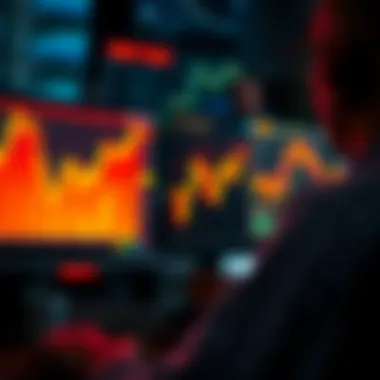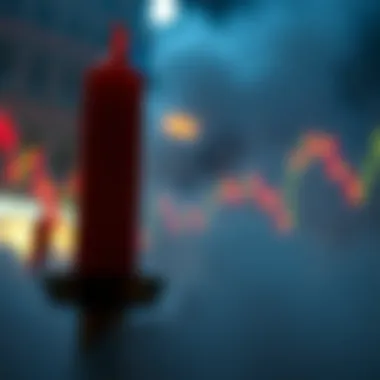Understanding the Meaning of Red Candles in Trading


Intro
In the ever-evolving world of cryptocurrency trading, understanding market signals can feel like trying to catch smoke with your bare hands. One of the most significant indicators traders encounter are red candles on candlestick charts. But what exactly do these red candles signify? For both seasoned investors and novices, grasping the meaning behind red candles could be pivotal in making informed trading decisions.
Red candles symbolize a price decrease over a specific time frame, suggesting bearish sentiment within the market. They're more than mere representations of price drops; they encapsulate the collective psychology of traders, revealing how market participants feel about ongoing trends. In this section, we'll peel back the layers on the intricacies of red candles, examine their role in technical analysis, explore their impact on market sentiment, and discuss strategies for navigating the volatile waters that often accompany such signals. Understanding these elements is not just important for reading charts—it's crucial for crafting effective responses to those chart movements.
Let's dive into the fundamentals of cryptocurrency to set a solid foundation before we dissect the implications of those crimson signals.
Understanding Candlestick Patterns
In the universe of trading, particularly within the dynamic realms of cryptocurrencies and stocks, candlestick patterns serve as vital beacons for investors and traders. Understanding these patterns is crucial, as they provide significant insights into market behavior, price movements, and potential reversals. Enter the candlestick, a visual representation that encapsulates the highs, lows, opening, and closing prices over a set period. While red candles specifically signal downward trends, a comprehensive grasp of candlestick patterns allows traders to interpret various market signals more accurately, enhancing their decision-making processes.
One of the primary benefits of mastering candlestick patterns lies in their simplicity. Unlike intricate financial models, candlestick charts are straightforward yet immensely informative. They help shed light on market sentiment, indicating whether buyers or sellers are dominating the scene. For example, a series of red candles may suggest continued selling pressure, whereas a shift to green candles can indicate a potential reversal.
Moreover, understanding these patterns encourages traders to consider various contexts. Different markets and time frames can show unique dynamics. What works in one scenario may not hold water in another. Being aware of these nuances equips investors with the acumen needed to react and adapt to fluctuations in market movements.
Ultimately, familiarity with candlestick patterns fosters a more intuitive grasp of market psychology. Traders can learn to read the signs and gauge emotional responses, which ultimately steer the market's direction. By refining their abilities to interpret these patterns, traders and investors stand better prepared to navigate the roller coaster of market trends effectively.
The Role of Color in Candlesticks
The role of color in candlestick patterns can’t be overstated. Color serves as visual shorthand, signaling important price movements and market sentiments at a glance. When traders glance at charts filled with colorful symbols, each color tells its own story. In particular, red candles play a significant role in expressing bearish sentiment in the market. Understanding this color scheme is not just a matter of aesthetic appeal; it’s a vital part of deciphering market trends.
Interpreting Color Symbols
Colors in candlestick charts are not arbitrary; they represent vital market sentiment. Generally, green candles indicate upward price movement, while red candles signify downward movement. For a trader, interpreting these colors offers immediate insight into the market’s direction.
Here are some crucial aspects of color interpretation:
- Momentum Direction: A sequence of red candles might suggest persistent bearish momentum, indicating that sellers are driving down the price. Conversely, frequent green candles may hint at growing bullish sentiment when buyers dominate.
- Market Sentiment: A single red candle might not be significant on its own, but in combination with previous charts, it can paint a clearer picture of overall market health.
- Timeframes Matter: The interpretations may differ across various contexts. For a day trader, a red candle on a 5-minute chart might be alarming, while a swing trader could interpret the same red candle on a daily chart as part of a necessary correction.
Ultimately, understanding how to interpret color symbols can empower traders to make more informed decisions as they navigate the often tumultuous waters of financial markets.
Red Candles Explained
Red candles represent more than mere visual markers; they encapsulate trader psychology and market dynamics. A red candle forms during time periods where opening prices exceed closing prices, visually betrayed by its downward wick leading to a body painted in red. Here’s what a red candle indicates more specifically:
- Negative Price Action: Simply put, red candles are synonymous with price declines. Traders often view them as signals of failing upward momentum.
- Market Sentiment Shift: A rise in red candles might mean an absorption of positive sentiment, often resulting from external factors—such as news, earnings reports, or macroeconomic data—that provoke uncertainty among investors.
- Potential for Reversal: On occasion, a series of red candles can serve as a prelude to either a consolidation phase or even a bullish reversal. With enough trader conviction, buyers may enter and create a rally against the prevailing trend.
Understanding red candles entails more than knowing they represent negative price movement. They are signals of market psychology, capable of informing traders not just about existing conditions, but also possible future trends.
Understanding red candle dynamics can be essential to trading success, providing insights into both market sentiment and potential future movements.
Through thoughtful analysis and interpretation of red candles, traders and investors can better position themselves in a fast-changing landscape, making decisions rooted in an accurate assessment of risk and opportunity.
For more detailed information on candlestick patterns, consider exploring resources like Investopedia or Wikipedia.
Organizations focused on market insights, such as TradingView and forums like Reddit, can also provide valuable community knowledge.
Market Psychology and Red Candles
Market psychology plays a pivotal role in understanding trading behaviors and decisions, especially when it comes to red candles on charts. Red candles often signal a drop in prices and can evoke a range of emotional reactions from traders and investors. This section delves into how the psychology behind trading dynamics influences responses to these downtrends.
The psychology of traders is inherently tied to market movements. Red candles can trigger feelings of anxiety, uncertainty, and fear, which impact decision-making. Particularly in volatile markets such as cryptocurrencies, a single red candle can shift trader sentiment in a heartbeat. Here’s how these emotions can influence trading strategies:


- Instant Reaction: When traders see a red candle, their initial instincts might push them toward panic selling. This impulsive behavior can cause price drops to accelerate, leading to a further decline in market value.
- Herd Mentality: Humans are inherently social creatures. When one trader decides to sell during a downtrend, others might follow suit, believing that this is the consensus move. This collective reaction can spiral out of control, intensifying the downtrend.
- Loss Aversion: Investors often feel the sting of losses more than the joy from gains. This psychological principle can lead traders to sell hastily when facing red candles, prioritizing the avoidance of loss over strategic decision-making.
Understanding these psychological factors is crucial. Acknowledging that many traders react similarly can help investors navigate market trends with greater awareness and foresight.
Emotional Responses to Red Candlestick Patterns
Analyzing emotional responses to red candlestick patterns reveals nuances that are significant for traders. The sentiments that arise when confronted with such patterns range from disbelief to full-blown panic.
- Denial: Initially, some traders may have trouble accepting that the market is taking a downturn. They might cling to the hope that it’s just a temporary blip, which can waste precious time.
- Frustration and Anger: For those who recently bought into the market, seeing red candles can trigger feelings of frustration. They might direct their anger towards the market, other investors, or even themselves for not predicting the downturn.
- Depression: Over time, constant exposure to red candles might lead to a sense of hopelessness. Traders can start to feel disillusioned, particularly if they repeatedly experience losses, affecting their future trading approach.
Understanding these emotional currents can lead to better-equipped traders who are able to manage their responses.
Fear and Panic Selling
Fear and panic selling is a common phenomenon when markets show signs of weakness, represented by red candles. This fear can cause traders to act without thinking critically about their investments.
Here are a few points to consider about this pattern:
- Immediate Reactions: When traders see consecutive red candles, the immediate response may be to sell off their assets to cut losses quickly. This reaction is often driven by the primal instinct to avoid further harm.
- Impact of News: External news—be it economic reports, regulatory changes, or broader market trends—can amplify the emotions felt during such downturns. A single negative headline can trigger widespread panic selling, exacerbating the drop.
- Perpetuation of the Cycle: Fear begets fear. As more traders sell, causing prices to plummet, it can lead to a self-fulfilling prophecy where fear drives the market lower, creating an atmosphere where rational thinking often takes a backseat.
In summary, understanding the dynamics of fear and panic selling helps traders develop strategies to mitigate their impact. By recognizing these triggers in advance, traders can approach market fluctuations more strategically rather than reactively.
Implications of Red Candles
The implications of red candles in market analysis extend far beyond their surface appearance on a chart. For traders and investors, red candles are not merely indicators of declining prices; they are symbols of market sentiment and psychological trends. Understanding these implications can significantly affect decision-making in a volatile trading environment.
One of the primary reasons for dissecting red candles is to gauge market direction. A series of red candles often hint at a downtrend, where sellers dominate, forcing prices down and establishing a bearish sentiment. This can serve as a signal for traders to review their positions, potentially adapting their strategies accordingly. In this light, one could argue that red candles act as early warning signs, alerting traders to monitor market conditions closely.
Moreover, it’s crucial to consider the context in which these red candles appear. A solitary red candle amidst a bullish trend may not carry the same weight as multiple red candles seen consecutively. As a trader, evaluating the surrounding price action helps to clarify whether a brief dip is merely a pullback or a sign of a deeper trend reversal.
Red Candles in Downtrends
When red candles populate the charts during a downtrend, they can paint a vivid picture of bearish sentiment taking hold. During such phases, market psychology shifts, often fueled by fear and uncertainty. Traders may interpret the incessant decline as a sign of a weakening asset. This atmosphere can lead to selling pressure, as inexperienced traders panic and exit positions fearing further losses.
Factors such as news events or economic indicators can exacerbate the situation. Investors may react to negative developments by intensifying their selling, reinforcing the downtrend.
It's essential to recognize red candles in this context as not just moments of price decline, but as signals of deeper market issues. Traders should, therefore, be cautious. It's wise to take a step back, reassess risk exposure, and question the fundamental reasons behind an asset's decline.
Potential Bullish Reversals
Interestingly, red candles don't always signal doom and gloom. Under certain conditions, they can actually denote potential bullish reversals. Consider this: if a stock or cryptocurrency displays a significant number of red candles, yet the decline starts to slow, that may hint at an exhaustion of sellers.
This scenario often manifests at support levels or prior resistance, where buyers may step in strategically, viewing the lower prices as an attractive opportunity.
When spotting potential reversals after a lengthy downtrend, traders should look for patterns such as hammer candles or engulfing formations, which signal a shift in momentum. The interplay between red candles and subsequent green candles can provide further affirmation that a reversal may be in the cards.
Technical Analysis Techniques Involving Red Candles
Technical analysis is a crucial aspect of understanding market dynamics. When it comes to red candles, they reveal deeper trends and potentially predictive patterns that can inform trading decisions. Recognizing how to incorporate red candles into your analysis makes a significant difference in strategy formulation. It helps traders not merely follow trends but also anticipate market movements. This section will explore two main techniques: trend analysis using red candles and complementary indicators that can enrich your trading insights.
Using Red Candles in Trend Analysis


Trend analysis stands as a cornerstone of technical trading. Red candles are often beacons indicating bearish sentiment, but their significance goes beyond mere color. In essence, they plot a narrative of the market's mood:
- Short-term movements can show an immediate response to news or events. This might signal a reactionary dip in price, making it essential to read the red candles within the context of their occurrence.
- Long-term trends can help identify bearish phases in a wider market context. Traders who look at several red candles in succession might well deduce a sustained downward momentum.
In practical terms, you can utilize a combination of time frames. For instance, if you're seeing red candles on both daily and weekly charts, this can signal a stronger downward trend than if the red candles merely appear on a single daily chart. Candlestick peaks and troughs alongside red candles can also disclose support and resistance levels, enriching your perspective on market behavior.
Indicators that Complement Red Candlestick Patterns
Once you've recognized red candles present in your analysis, a smart trader doesn't stop there. You should also consider several indicators that can lend additional weight to your assessments:
- Moving Averages: By analyzing the interaction between price action indicated by red candles and moving averages, traders can confirm a trend’s strength. For instance, a red candle crossing below a moving average might suggest imminent bearish action.
- Relative Strength Index (RSI): The RSI gauges overbought or oversold conditions. If a red candle appears alongside an RSI indicating overbought status, it’s a strong hint to rethink your positions.
- Volume Analysis: Understanding volume can determine if a red candle's momentum is backed by significant selling pressure. Higher volume alongside a red candle often indicates stronger sentiment behind that price movement.
In summary, while red candles can serve as warning flags in the markets, they shouldn't be taken at face value. They have to be studied through a lens of broader technical analysis. By combining them with other indicators, traders can build a more robust picture of potential market movements.
"In trading, knowing how to read between the lines often separates the amateurs from the professionals."
Understanding technical analysis techniques revolving around red candles is a skill that can propel a trader from good to great.
Risk Management Strategies
Risk management is a pivotal element in the world of trading, especially when navigating the treacherous waters associated with red candles. The significance of this strategy cannot be overstated. Investors and traders alike face inherent risks when the market is wavering. Red candles often signal bearish sentiments, and without a sound risk management plan, capital can be swiftly deceased. Properly implemented risk management strategies help mitigate potential losses, preserving one's capital for future opportunities. It also instills a level of discipline and emotional control in traders, factors that are often overlooked amid market volatility.
Setting Stop-Loss Orders
Stop-loss orders serve as a practical tool to guard against hefty losses. When you’re observing a red candle indicating a downward price movement, it’s crucial to have a stop-loss strategy in place. It involves pre-setting an order to sell a security once it reaches a certain price, preventing further losses that can arise from unchecked declines. Here are some key aspects to consider:
- Automatic Execution: A stop-loss takes emotion out of the decision-making process. Traders can set it and forget it, avoiding those knee-jerk reactions that often lead to poor choices.
- Customized Thresholds: Every trader has their risk tolerance. Setting personalized stop-loss levels based on historical price action and personal financial situations can provide an added layer of comfort.
- Market Conditions: Always consider prevailing market trends. For instance, if the market sentiment is drastically bearish, a more conservative stop-loss might be prudent to avoid getting swept away in a sharp downturn.
Setting effective stop-loss orders can absolutely be a game changer. It allows traders to sleep a little easier at night knowing that they have protected themselves against facing major financial hits.
"In trading, it is not about how much you make, but how much you don’t lose."
Diversification as a Defense Mechanism
Diversification is another fundamental concept in risk management. The premise is simple: don’t put all your eggs in one basket. By spreading investments across various assets, sectors, or geographical locations, investors can cushion themselves against market fluctuations. Consider these elements:
- Asset Mix: Having a portfolio that includes a mix of stocks, bonds, ETFs, and perhaps even some cryptocurrencies can balance out the risks associated with any one asset class.
- Reducing Exposure: In a scenario where red candles are prevalent in a given sector, having investments in other sectors could potentially offset losses, allowing for other parts of the portfolio to remain viable.
- Market Analysis: Constantly analyze which sectors show robustness and which might be on shaky ground. This enables proactive adjustments to a diversified portfolio, maintaining resilience against market shocks.
In practice, diversification not only helps in mitigating risks but also enhances overall growth potential, as various investments may fluctuate in value at different times. This layered approach to risk management is vital, especially in environments marked by unpredictability.
Case Studies Involving Red Candles
Understanding case studies involving red candles is essential for those who seek insights from historical data in financial trading. These studies not only highlight the direct impacts of red candles on market performance but also provide a lens through which traders can refine their strategies.
Analyzing Historical Market Events
Exploring historical market events that prominently featured red candles can illuminate trader responses and market dynamics during those periods. Events like the dot-com bubble burst or the 2008 financial crisis serve as prime examples.
During the dot-com crash, many tech stocks experienced a series of downward trends indicated by consistent red candles. As these stocks spiraled down, the visual representation on candlestick charts signified a shift in investor confidence. Traders learned that the presence of red candles could herald signs of panic or sweeping market corrections.
Similarly, in 2008, we witnessed dramatic red candles in various markets. Lehman Brothers’ collapse, a defined tipping point, led to widespread fear, creating a chaotic environment laden with red signals on charts. By analyzing these patterns, traders gained insights into how long stretches of red could foreshadow possible rebounds or forewarn of potential losses. The psychological effects on traders presented in these case studies illustrate the historical significance of red candles as barometers of trader sentiment.


Learning from Major Market Crashes
The aftermath of major market crashes emphasizes the importance of recognizing red candles and their implications. It’s not just the color that matters; it’s how they serve as indicators of broader economic health. For example, after the 2008 recession, financial analysts revisited candlestick patterns and noted that the early identification of red candles could mitigate losses in future downturns.
Traders have also learned to reassess their risk-taking strategies in the wake of crises. Some key insights derived from these studies include:
- Set clear stop-loss orders: Understanding where to cut losses is critical during bearish trends indicated by red candles.
- Diversification tactics: By spreading investments across various asset classes, traders can buffer against the panic that accompanies a red candle on a single stock.
- Emotional awareness: Recognizing personal reactions to red signals can avoid impulsive decisions borne out of fear.
"In trading, every red candle isn't simply a negative signal; it’s an opportunity for keen analysts to rethink strategy and adapt to market changes."
These lessons, gleaned from past events, continue to shape trading strategies in today’s markets. Their ongoing relevance suggests that traders must maintain vigilance and apply insights from these case studies to better navigate future uncertainties.
Red Candles and Trading Strategies
Understanding how to navigate red candles can prove invaluable for traders and investors alike. Intrinsically tied to market sentiment and price movements, the interpretation and utilization of red candles can illuminate potential strategies that enhance trading success. In this section, we will explore how to effectively incorporate red candles into trading plans, as well as how to sidestep common missteps that can lead to poor decision-making.
Developing Trading Plans Around Red Candles
Creating a solid trading plan that includes red candles hinges on recognizing their implications early on. A red candle generally reflects a period where sellers are in charge, thus implying bearish sentiment. However, understanding the context—such as trading volume and preceding patterns—is key to making informed decisions.
- Establish Entry and Exit Points: By paying close attention to red candles’ appearance, traders can establish strategic entry and exit points. For instance, if a trader notices a series of red candles developing after an extended uptrend, it may signal a potential reversal or at least a short-term dip, prompting a decision to exit early to minimize losses.
- Consider Trend Resistance: One could also analyze red candles in relation to trend resistance levels. When a red candle forms right at a resistance level, it may indicate that buyers are exhausted, presenting a prime opportunity to short the asset.
- Review Support Levels: Conversely, if many red candles appear near historically strong support levels, it could also provide insights into potential reversal behavior. On occasion, a sustained drop can lead to oversold conditions, causing prices to rebound, which can be an indicator to enter the market.
By integrating red candles into forethoughtful trading strategies, investors can align their decisions with market psychology, utilizing downward trends to their advantage.
Avoiding Common Pitfalls
Though red candles can be insightful, relying solely on them without considering broader market dynamics can lead to pitfalls. Here are stratigies to avoid potential traps:
- Don't Trade Emotionally: Reacting solely to red candles can provoke impulsive trading decisions driven by fear or panic. Instead, sticking to a pre-established plan allows for strategic control.
- Over-trading with Red Signals: Some traders might incorrectly interpret a single or even several red candles as a surefire sell signal and engage in over-trading. This behavior often leads to increased transaction costs and could negatively impact overall profitability.
- Neglecting Market Context: Focusing only on red candles without considering fundamental analysis or other technical indicators can distort the market picture, leading to hasty conclusions.
"In trading, patience is often more rewarding than impulsive decisions."
In summary, an effective trading strategy that embraces red candles requires careful observation and an understanding of the larger market context. By formulating plans and avoiding emotional traps, traders can harness the power of red candles to navigate challenging market conditions more adeptly.
Consider utilizing platforms like reddit.com for community insights or finance blogs that explore current market sentiment. This kind of broader community engagement can provide additional perspectives on strategies that center around red candles.
Future Trends and Observations
The landscape of market analysis is always shifting, and understanding the significance of red candles holds critical importance for traders and investors alike. This section dives into the mechanisms that shape these trends and how they inform decision-making in volatile markets. As we explore the evolutionary path of candlestick analysis and the distinct role red candles play in emerging markets, the goal is to provide a comprehensive lens through which to view future trading dynamics.
The Evolution of Market Candlestick Analysis
The history of candlestick analysis stretches back to 18th century Japan, where rice traders first developed this technique to make sense of fluctuating prices. Over time, this method has morphed into a robust analytical tool utilized globally across various asset classes, including stocks, commodities, and cryptocurrencies.
- Integration of Technology: Modern advancements have brought candlestick charting into the digital realm, empowering traders with sophisticated platforms that streamline analytics. Tools such as TradingView and MetaTrader 4 offer real-time data, enabling traders to visualize patterns, including red candles, with precision.
- Data-Driven Decisions: With immense amounts of data at traders' fingertips, the analytical approach has shifted. Algorithms now assist in identifying patterns that may be indicative of market shifts. Red candles, specifically, are often analyzed in conjunction with other indicators to make more informed predictions.
- Educational Resources: The digital age has democratized knowledge surrounding candlestick patterns. Countless articles, webinars, and forums exist where traders share insights about interpreting red candles. The community-based discussions often shine light on emerging strategies, keeping everyone on their toes.
Reflecting on these shifts, we see that understanding candlestick patterns—including red candles—is no longer the domain of a select few but rather a collaborative effort where information flows freely across global platforms.
Red Candles in Emerging Markets
Emerging markets display unique characteristics that render the significance of red candles even more pronounced. In these markets, where volatility can become a daily hurdle, the insights gleaned from red candles could mean the difference between profit and loss.
Unique Features of Emerging Markets:
- Rapid Growth and Instability: Emerging markets are often characterized by rapid economic growth but can encounter sudden downturns. Here, red candles serve as vital signals that alert investors to potential market corrections before they snowball.
- Retail Investor Dominance: A significant portion of trading in emerging markets is conducted by retail investors, who might react more impulsively to red candles. This could lead to a self-fulfilling prophecy where fear spreads quickly in the face of these bearish signals, intensifying market downturns.
- Less Institutional Influence: The relative scarcity of institutional investors means that market movements can be more erratic. Red candles in these circumstances may represent greater alarm, leading to higher volatility as retail investors react without waiting for institutional analysis.
To summarize, interpreting red candles is crucial in emerging markets. They provide insights into market sentiment and can serve as beacons in a tumultuous environment, guiding traders to execute timely strategies. Overall, the analysis of these patterns speaks volumes about a trader's ability to adapt and remain ahead of market shifts.
In essence, understanding the significance of red candles is not just about following trends; it’s about evolving with the market.



